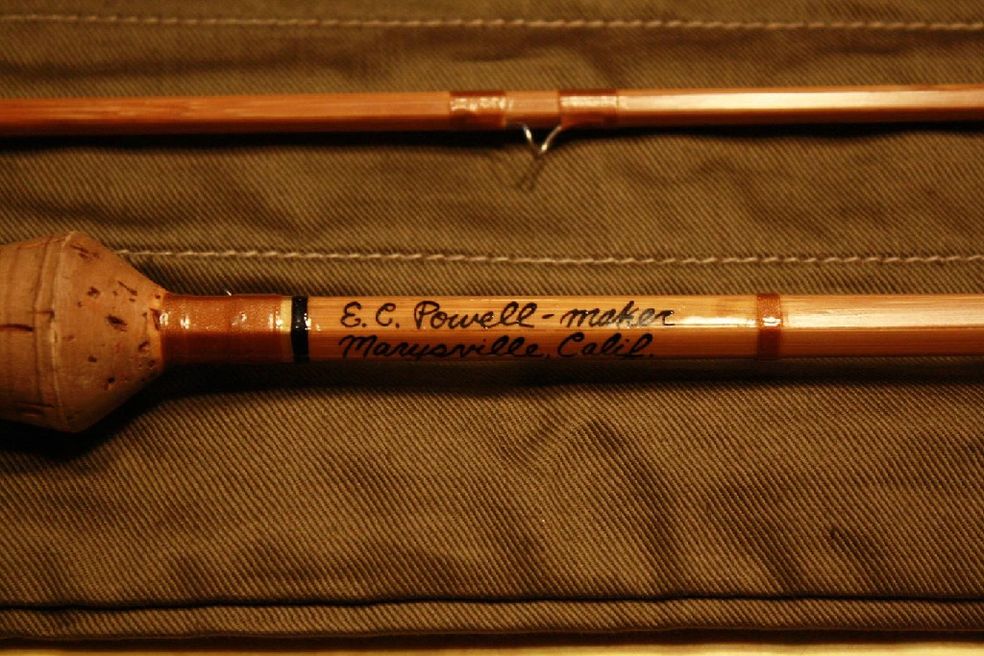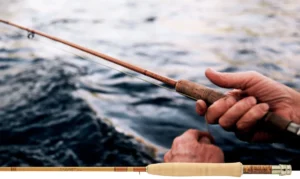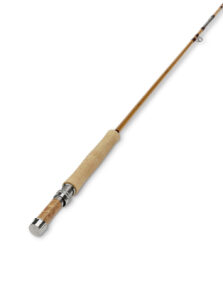
-
The E.C. Powell legacy began in the early 20th century, revolutionizing fly fishing with handcrafted bamboo rods.
-
Understanding the semi-hollow construction patented by E.C. Powell is essential to appreciating these rods.
-
Authentic Powell rods have distinct features that help identify their origin and value.
-
Collecting E.C. Powell rods is not only a hobby but a journey into the history and art of fly fishing.
The Beginnings of a Legendary Craft
Imagine a time when fly fishing was not just a pastime, but a pursuit of perfection in harmony with nature. This was the era when E.C. Powell, a visionary craftsman, started creating bamboo fly rods in Red Bluff, California. His dedication to the craft soon led him to move his workshop to Marysville, where the magic continued for decades. E.C. Powell was not just making rods; he was crafting legacies, each rod a testament to his passion for fly fishing and his innovative spirit.
These rods weren’t just sticks with strings; they were precision instruments, finely tuned to the angler’s hand and the river’s whisper. The bamboo used was not merely cut but selected, cured, and crafted with an attention to detail that bordered on the obsessive. This was the beginning of a legacy that would cast a long shadow over the world of fly fishing.
E.C. Powell’s Influence on Fly Fishing
E.C. Powell’s influence on fly fishing can’t be overstated. He wasn’t just building rods; he was setting the standard for what a fly rod should be. His work inspired generations of rod makers and anglers alike, making the Powell name synonymous with quality and performance. The rods he made were known for their ability to cast with precision and grace, qualities that are still sought after in fly fishing gear today.
But what truly set Powell rods apart was the semi-hollow construction that E.C. Powell patented. This innovation made the rods lighter and more responsive, a serious advantage when it came to tournament casting. It was this forward-thinking approach that kept Powell at the forefront of the rod-making industry and secured his place in the annals of fly fishing history.
Mastering the Craft: E.C. Powell’s Rod-Making Techniques
Semi-Hollow Innovation – Powell’s Patent
Now, let’s talk about that semi-hollow construction. In a time when fly rods were judged by their weight, E.C. Powell’s patented semi-hollow design was revolutionary. It allowed for a lighter rod that could cast further, a true game-changer. The patent number, often inked on the rod, became a mark of this innovation. It’s a feature that not only represents the rod’s authenticity but also its place in the evolution of fly fishing.
The process of creating a semi-hollow rod is intricate, involving the removal of material from the bamboo’s interior while maintaining its structural integrity. It’s a delicate balance, one that Powell mastered, and it’s why these rods are still celebrated today.
Understanding Rod Tapers – A, B, and C Explained
Understanding rod tapers is key to appreciating the finesse of a Powell rod. Tapers determine the rod’s action, its flexibility, and how it transfers energy during the cast. E.C. Powell developed three primary tapers: A, B, and C. Each taper has its own characteristics, designed to suit different fishing conditions and casting styles.
The ‘A’ taper is aggressive, built for power and distance. The ‘B’ taper, Powell’s most popular, offers a balance of flexibility and strength, suitable for a variety of fishing scenarios. The ‘C’ taper is more specialized, providing a delicate touch for precise presentations. By understanding these tapers, anglers can select a Powell rod that matches their fishing style and the challenges of the waters they face.

Identifying Authentic Powell Rods
As a collector or enthusiast, identifying an authentic Powell rod is like discovering a piece of fly fishing history in your hands. The rods often bear unique marks of authenticity, such as E.C. Powell’s signature, the patent number, or specific wrap colors. These details are not just for show; they tell a story of the rod’s origin and its journey through time.
Spotting Marks of Authenticity
To spot an authentic Powell rod, you should look for several key indicators. Firstly, the presence of a label or stamp with E.C. Powell’s name is a telltale sign. Additionally, many Powell rods feature two-color wraps, typically black and cream, which are distinctive to the brand. The original rod tube and cap, often carrying a label with the rod’s specifications, can also provide clues to the rod’s authenticity.
Another important aspect is the rod’s length and the number of sections. Most of Powell’s rods were designed with two tips, so a complete set would include one butt section and two matching tips. The craftsmanship, from the precision of the ferrules to the alignment of the guides, reflects the quality that E.C. Powell insisted upon.
Decoding the Patented Features
The patented semi-hollow design is a defining feature of many Powell rods. If you come across a rod with the patent number inked on it, chances are it’s a genuine Powell semi-hollow. This design not only contributes to the rod’s lighter weight and casting ability but also serves as a hallmark of E.C. Powell’s ingenuity.
Because the semi-hollow construction was so innovative, it’s worth consulting an expert if you’re unsure about a rod’s authenticity. The subtle nuances in the bamboo’s texture and the feel of the rod in action can be difficult to discern without a trained eye.

From Past to Present: Collecting E.C. Powell Rods
Collecting E.C. Powell rods is more than a hobby; it’s a journey into the heart of fly fishing tradition. Each rod tells a story, and adding one to your collection is a way to connect with the history of the sport.
The Hunt for Vintage E.C. Powell Rods
The hunt for vintage E.C. Powell rods can be as thrilling as the fishing itself. These rods can be found in antique shops, estate sales, and online auctions. When searching for a Powell rod, it’s important to do your homework. Research the seller’s reputation, ask for detailed photos, and inquire about the rod’s history. A genuine Powell rod, especially one in good condition, can be a significant investment, so due diligence is key.
Also, consider joining collector groups or forums where you can connect with other enthusiasts. They can be invaluable resources for information and may even lead you to your next great find.
Understanding the Collector’s Market
The collector’s market for E.C. Powell rods is vibrant and varied. The value of a rod can depend on several factors, including its condition, rarity, and historical significance. Some collectors seek rods for their fishing prowess, while others are more interested in their craftsmanship and place in fly fishing lore.
When evaluating a rod, consider the following:
-
The rod’s condition: Are there signs of wear, or is it in pristine condition?
-
Original components: Does the rod have its original ferrules, wraps, and finish?
-
Provenance: Can the rod’s history and previous ownership be traced?
-
Market demand: How sought after is the model or taper?
By understanding these factors, you can make informed decisions and potentially find a Powell rod that will appreciate in value and sentiment over time.
-
The E.C. Powell legacy began in the early 20th century, revolutionizing fly fishing with handcrafted bamboo rods.
-
Understanding the semi-hollow construction patented by E.C. Powell is essential to appreciating these rods.
-
Authentic Powell rods have distinct features that help identify their origin and value.
-
Proper care and maintenance of bamboo fly rods can preserve their functionality and beauty for generations.
-
Collecting E.C. Powell rods is not only a hobby but a journey into the history and art of fly fishing.
Frequently Asked Questions
What Makes Bamboo Fly Rods by E.C. Powell Special?
Bamboo fly rods crafted by E.C. Powell are special because of their meticulous handcraftsmanship, the use of quality Tonkin cane, and the innovative semi-hollow construction that Powell patented. This combination of materials and design results in a fly rod that is not only lightweight and capable of precise casting but also steeped in the tradition and history of the sport.
How Do I Identify the Taper of My E.C. Powell Rod?
To identify the taper of your E.C. Powell rod, you’ll need to understand the characteristics of the A, B, and C tapers developed by Powell. Look for markings on the rod that indicate its model, and compare the rod’s action and flexibility. For a definitive identification, consulting with a bamboo rod expert or a collector’s guide is recommended.
Can E.C. Powell Rods Be Used in Modern Fly Fishing?
Absolutely! Despite their age, E.C. Powell rods remain highly functional and are often prized for their performance in modern fly fishing. Their ability to delicately present flies and the unique feel of bamboo make them a joy to fish with. However, it’s important to ensure that the rod is in good condition and properly maintained to get the best experience.
Where Can I Find Information About E.C. Powell’s Innovations?
-
Books and publications on the history of fly fishing and rod making.
-
Collector’s guides and forums dedicated to bamboo fly rods.
-
Museums or exhibits featuring historical fishing gear.
-
Workshops or talks by experts in the field of bamboo rod craftsmanship.





